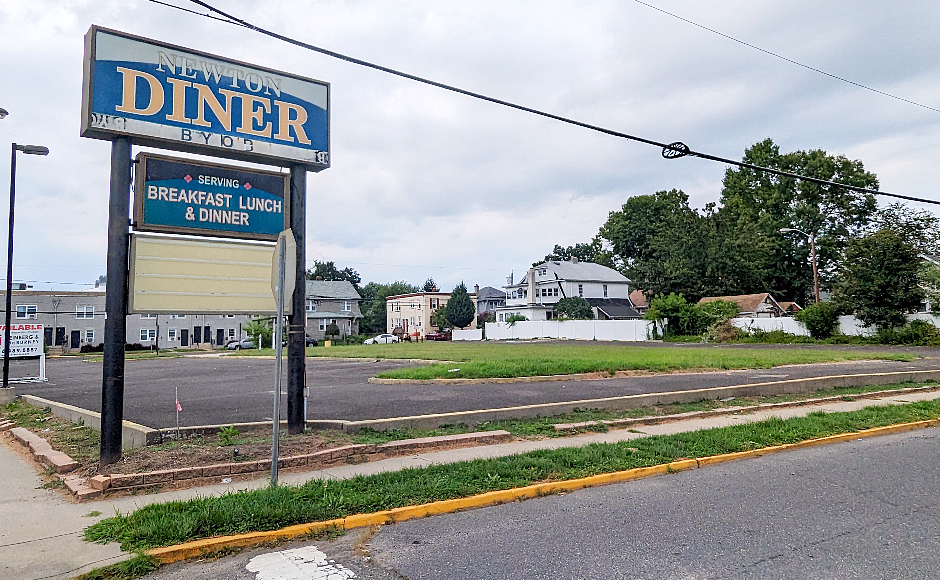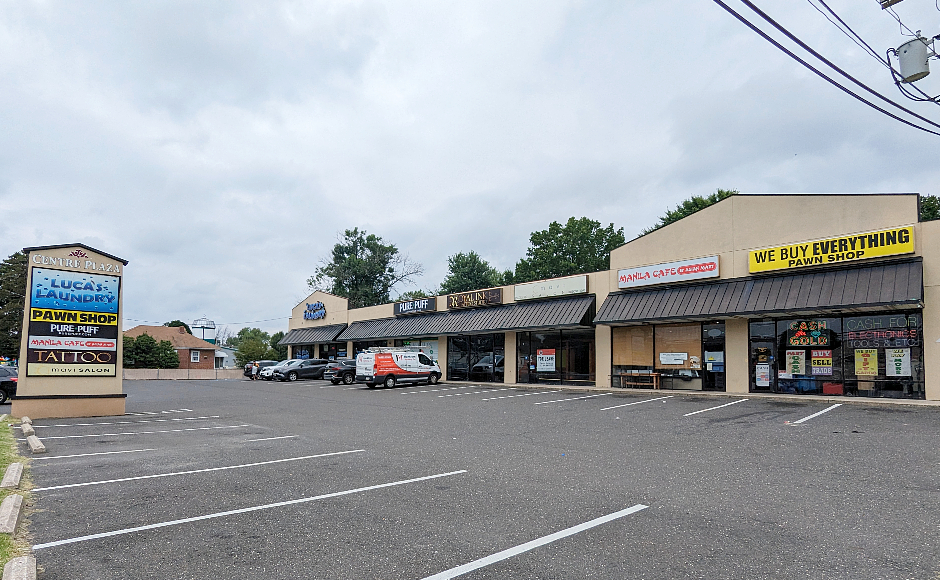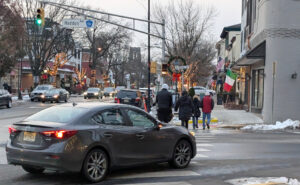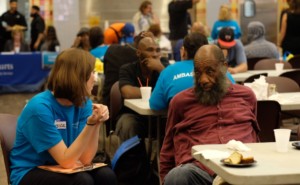In a 6-3 vote, the Haddon Township Planning and Zoning Board shot down variance requests attached to plans approved a decade earlier for the property.
By Matt Skoufalos | August 4, 2023
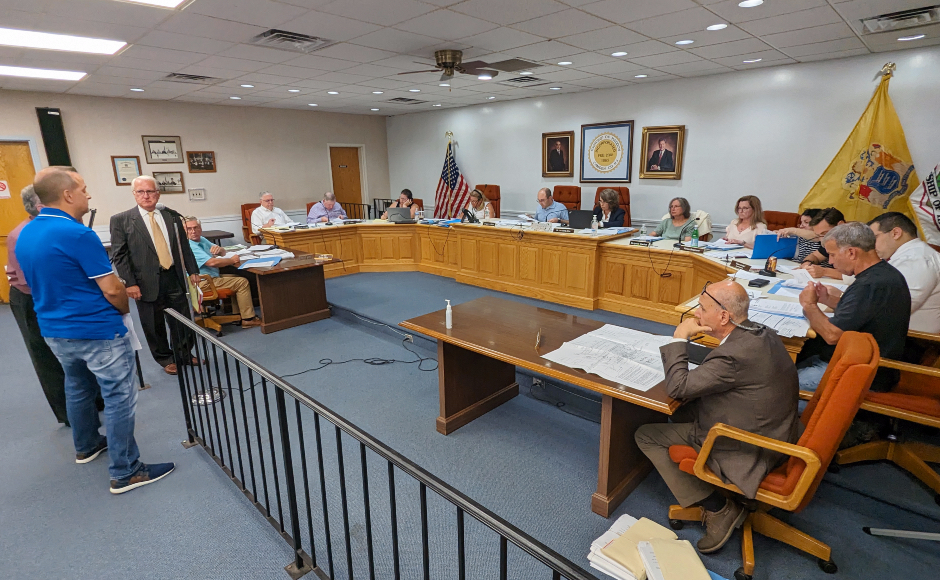
Paolo Colombo presents plans for a White Horse Pike strip mall to the Haddon Township Planning and Zoning Board. Credit: Matt Skoufalos.
After some three hours of deliberation Thursday, the Haddon Township Planning and Zoning Board rejected a proposal to redevelop the site of the former Newton Diner into a 10,092-square-feet, multi-tenant strip mall.
The applicant, Paolo Colombo, presented plans for the space that had been approved by the township a decade ago, his engineer, Jack J. Gravlin, Jr. said.
Approvals for those plans, “with all the same variance and waivers we’re requesting,” were first issued in 2013, Gravlin, Jr. said, but “the applicant, at that time, failed to act upon those approvals, and did not seek extensions.”
Colombo owns “an almost identical center on the White Horse Pike in Somerdale,” his attorney, Peter Rhodes, testified, which he sought to replicate in Haddon Township.
That property, Centre Plaza, includes a laundromat business that Colombo owns and operates. At the time of the meeting, it was the lone confirmed tenant for the eight-commercial-unit building he’d proposed for the 0.72-acre lot at 931 White Horse Pike in Haddon Township.
Gravlin, Jr.’s design would have reduced pervious coverage at the site by about 5,700 square-feet, or 18 percent of the lot; relocated existing water and sewer lines behind the new building; and added landscaping and privacy fencing along its rear border with residential properties on Holly and Park Avenues.
“We are increasing the open and green landscaped area considerably,” Gravlin, Jr. said. “The additional landscaping will result in a significant visual improvement to the business corridor.”
However, the proposal also sought relief from parking, signage, and waste removal standards for the C-1 commercial district in which the property is located. As designed, the project would have required 55.5 parking spaces; Colombo proposed 31 instead.
He also sought a variance from local ordinances to build a freestanding highway sign at the corner of Holly Avenue and the White Horse Pike; Haddon Township Engineer Greg Fusco countered with the offer of a multi-tenant monument sign instead.
Colombo was amenable to a suggestion that he modify his garbage removal strategy to include 90-gallon rollaway totes instead of a six-yard dumpster that would have routed trash trucks through the neighborhood.
However, his proposal did not conform to standards for building setbacks in the district, nor for driveway proximity to the right-of-way onsite.
Furthermore, the plans also lacked a loading zone for deliveries to the plaza, and would have positioned its parking lot at the front of the building instead of aligning a zero-setback frontage with the White Horse Pike.
“The zone is really geared towards the building pushed all the way up against the sidewalk,” Fusco said.
As the site is located on U.S. Route 30 (the White Horse Pike), Colombo was also awaiting approval of his proposed design waivers from the New Jersey Department of Transportation, which had not yet made a determination at the time of his application to the township.
Residents in the immediate area of the project were uniformly negative about both its prospective impact on their neighborhood and the notion of constructing a strip mall in what is ostensibly the Haddon Township arts district.
“Anything is better than the nothing in that lot,” said Ormond Avenue resident Matt Nelson. “I don’t think you can look at it and say anything differently. It is a blank slate on the White Horse Pike. There’s a real opportunity to do something good there.
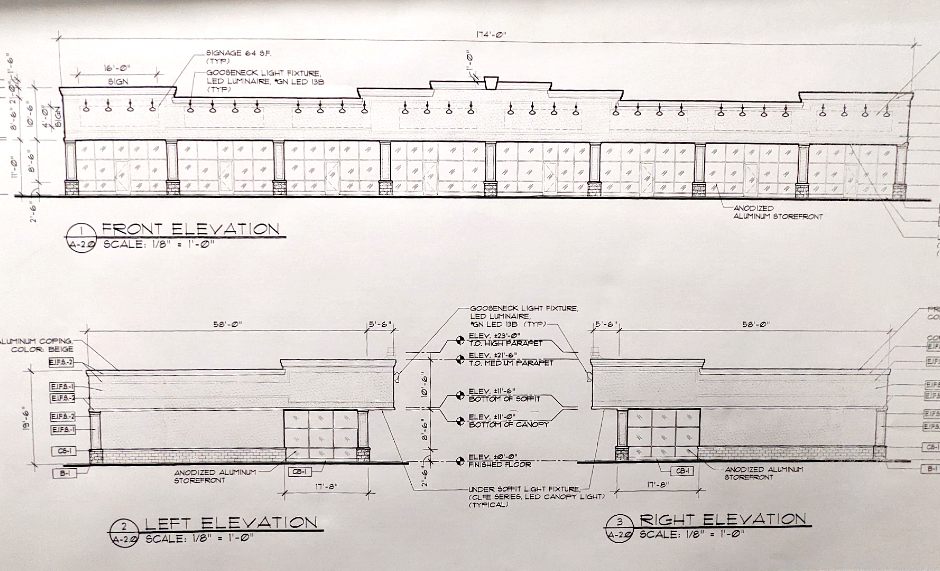
Building elevations for Paolo Colombo’s redevelopment proposal of the former Newton Diner site in Haddon Township. Credit: Matt Skoufalos.
“The question is what is being proposed to you,” Nelson said; “what is being proposed is a strip mall.
“We have the opportunity to literally put anything in there to enrich Haddon Township,” he continued. “The evidence on the table says we can’t put tenants in the empty storefronts that are already there. Why does that need to go there?”
Samantha Carell, Director at the nearby SoHa Arts Building, described the property as “a high-traffic area” that also has “a huge issue with flooding on the corner of the street,” where SoHa tenants routinely make and receive deliveries. She suggested that the site might better be conceived as a project that ties in with the stretch of highway bookended by SoHa and the Ritz Theatre.
“We are somewhat the unofficial art district of Haddon Township, and it would be a great honor to see it continue in that aspect,” Carell said.
Lauren Cybulski of East Park Avenue worried that if the proposal were approved with insufficient parking, it would further burden a neighborhood that already has intense vehicle usage.
“You limit the parking in the lot, what happens is the people who are working in those retail are now parking on the side streets,” Cybulski said.
“People come flying off the White Horse Pike,” she said. “I’m concerned about entrances and exits. We pride ourselves on being a walking district, but my 10-year-old can’t walk to and from [Clyde S. Jennings Elementary] school, and I live around the corner [from it].”
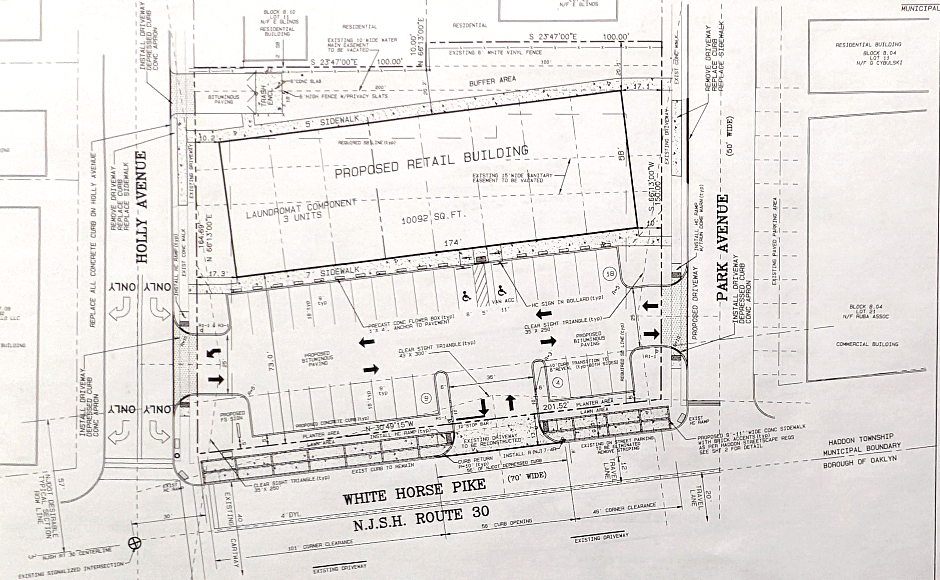
Paolo Colombo’s redevelopment proposal for the former Newton Diner site in Haddon Township. Credit: Matt Skoufalos.
“The joke in that neighborhood is that East Holly is a raceway because that light stinks,” said East Holly Avenue resident Alex Madjeska. “They race down our street the wrong way all the time.
“I love the Ritz,” Madjeska said. “I love SoHa; that brings culture. This is honestly just another crappy strip mall.”
Board members reminded the public that their jurisdiction is limited to applications of the local zoning standard, and not to choices of uses selected by the proposed developer if they conform to that standard.
“This board doesn’t have the authority, given the presentation of the application to say, ‘Well, you know what? We don’t need any more of those,” said board member John Foley.
“This is the first application that’s been made before this board for at least 10 years,” Foley said. “Our responsibility is to say, ‘Does this application fall within the regulations of the township?’”
Ultimately, the governing body decided not to approve the proposed variances by a vote of 6 to 3.
Board member Jim Stevenson summed up the reasoning for the decision by stating that the applicant simply hadn’t met the burden of proof as to why granting the variances would provide more of a community benefit versus the potential negative impact of relaxing local statutes.
Without those approvals, the application was rejected. Colombo concluded the meeting by telling the board he has no intention of bringing his proposal forward again.


